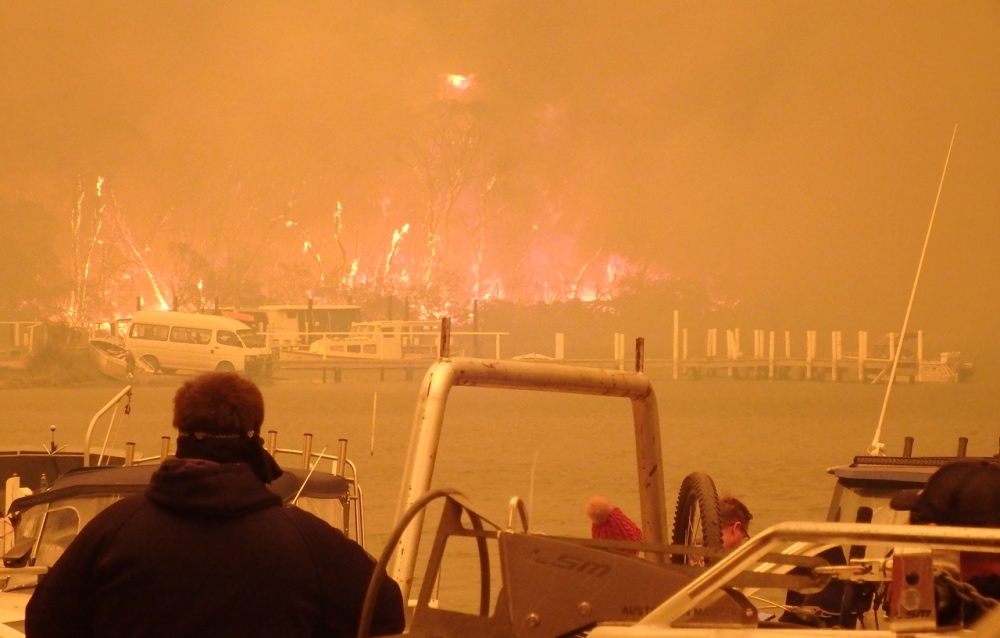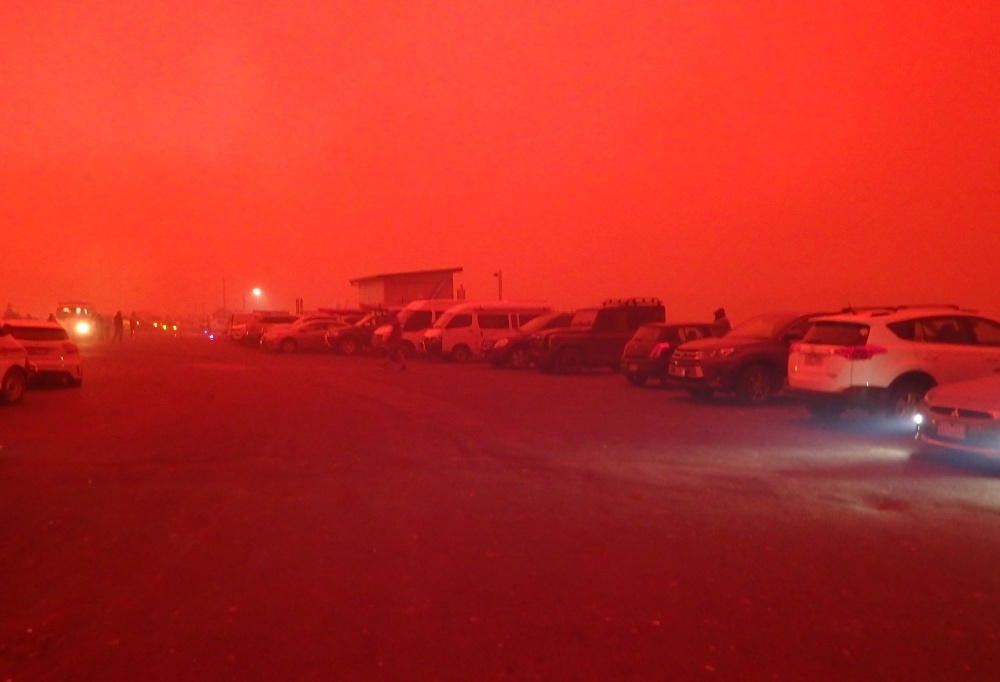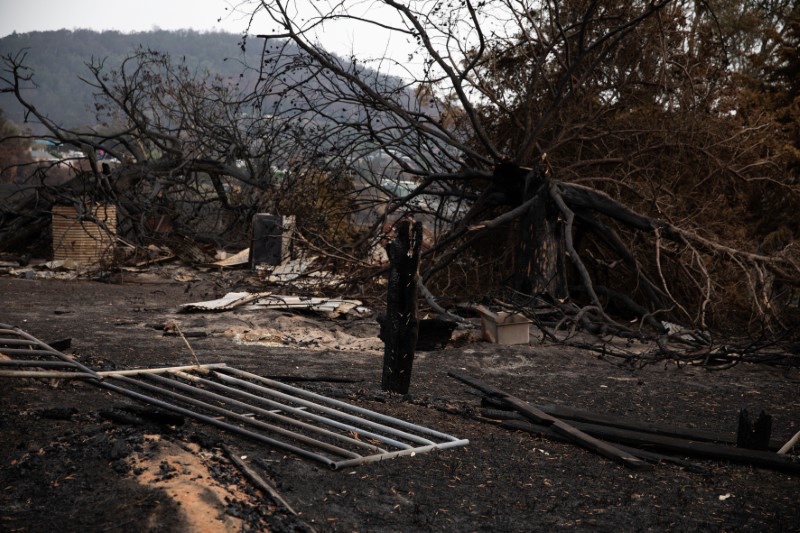
CHRISTOPHER GILBERT reports on how Christians and church agencies are responding to the weariness and the enormous destruction of three months of bushfires…
On New Year’s Eve – when thousands in the beachside Victorian town of Mallacoota barely escaped the annihilation of a mega bushfire, David Jeffery got a call from Australia’s national broadcaster, the ABC.
It was 20 minutes after the initial fire front had backed up.
“We could hear the fire roaring as it hit town, like a thousand locomotives coming at us,” he recalls saying.
“I started praying. I said ‘Lord, please, please, please turn the wind, turn it back like putting on the brakes!’ And literally, people know that I’m telling the truth, somehow it came from the east which is the opposite direction [from] where that front was coming.”

The fires near Mallacoota, Victoria, on New Year’s Eve. PICTURE: Brian Page.
Many Australians heard Jeffery, a Christian who runs a B&B in the town, tell the ABC and Sky News of his emboldened prayers and an easterly wind change that reversed and cooled an 18 metre firewall hurtling into the town at up to 90kph.
It was only a minute away from where he and about 4000 others huddled along the seawall. Such a reprieve relieved the fears of Australians everywhere, since news outlets had expected the worst. But that same night, 128 of the families on that rock wall who gained their lives lost their Mallacoota homes.
“I started praying. I said ‘Lord, please, please, please turn the wind, turn it back like putting on the brakes!’ And literally, people know that I’m telling the truth, somehow it came from the east which is the opposite direction [from] where that front was coming.”
– Mallacoota resident David Jeffery
For three months now, stories from Australia of loss of life and property thanks to the bushfires have captured global attention. But in communities where the fires have left a trail of destruction, Christians are now starting to take stock. Leaders of various church bodies have been visiting affected areas where they can – and planning for the long haul of rebuilding and rehabilitation of those displaced.
They’ve found people in the fire zones exhausted by dealing with threat-after-threat on their lives and homes and a complex situation involving local churches caring for friends and neighbours while Christian agencies figure out ways to channel resources to families who have suffered loss and trauma, including not just their own parishioners, but fire service personnel and volunteer emergency responders. And it’s all made more complicated by the difficulty of access, especially in more remote locations.
Mallacoota resident Jeffery says he was tipped off by a former fire chief of the gravity of what was coming. He spent two-and-a-half days preparing for the fire during which he managed to snatch only five hours of sleep. He felt responsible for older neighbours and the residents of his B&B, his beloved dogs, his absent children’s cat and even their ducklings and a rooster (these survived being penned with the cat at a seawall refuge).
Almost three weeks since that afternoon when fire threatened to consume the community, the town still lacks an open road along the Princes Highway to Orbost heading south-west towards Melbourne or north-east to the New South Wales towns of Merimbula and Eden. Heavy seas have also kept the town isolated from boat deliveries.
“Last week an army convoy had to make its way through fallen trees to deliver hay to a point where locals could pick it up for their stock,” Jeffery says. “Road clearing crews are staying here now and I’m reliably informed that it’ll be a month before the roads can be made safe.”
When Sight spoke to Jeffery last week, he was in the midst of helping neighbours make insurance claims for smoke damage and liaising with government agencies about what aid is available. He says local residents are all still processing what happened that night and doing their best to recover.
On the same day Sight spoke to Jeffery, John Clarke, director of mission for Uniting Church agency Uniting Vic/Tas, reports that the extent of road closures meant his teams couldn’t get into many of the worst-hit eastern Victorian towns to assess the needs. But he notes that Uniting workers had been active as volunteers throughout the emergency.
“Our emergency relief to the displaced, such as clothing and food, will be through our existing channels, like our local offices and op shops,” he says. “For financial help we’re recommending people use the Victorian government’s Fire Relief Fund through Bendigo Bank.”

Red skies over Mallacoota on 31st December, 2019. PICTURE: Brian Page.
Clarke says that Uniting Vic/Tas workers who experienced the aftermath of Victoria’s 2009 fires around King Lake are currently planning to provide social service assistance, psychological counselling and housing as well as address issues like domestic violence, and mental health needs – all of which emerged as necessary after that catastrophe 10 years ago.
Anglican Bishop Mark Short, who spoke to Sight from the New South Wales town of Eden where he was conducting a pastoral/reconnaissance trip through the south coast regions of the diocese he leads from his base in Canberra, says he is struck by the sheer scale of the emergency.
More than 1000 homes have been destroyed in his region – which extends west as far Wagga Wagga, across to the eastern seaboard towns of Nowra and Eden – plus public facilities, and some churches. Industrial areas have also been razed as well as farms and orchards in places like Batlow, all of which is expected to impact heavily on local economies.
Of 60 parishes in the diocese, Short counts 20 which had fires inside their boundaries. Bushfires destroyed a church building in Quaama and burnt the administrative building of St Peters Anglican School in Broulee. He reported no deaths among parishioners, but some lost houses in Tumbarumba and Cabramurra.
“Parishioners who volunteer in the evacuation centre in Bega say they have something like 4,500 people registered although they’re not necessarily all at the centre at the same time,” Short says. “That number doesn’t include the people who moved into town and found accommodation with friends.”
“People have been running on adrenalin. The threat elevates and recedes with the weather. So people have had the experience of being wound up and having to respond to a crisis, maybe move into an evacuation centre, the weather changes and they move back home. Then they’ve had to do it all again.”
– Anglican Bishop Mark Short
Speaking even as fires are still burning in the hills not far from Eden, like others, he comments on the tiredness of those who have been responding to the fires.
“People have been running on adrenalin. The threat elevates and recedes with the weather. So people have had the experience of being wound up and having to respond to a crisis, maybe move into an evacuation centre, the weather changes and they move back home,” he says. “Then they’ve had to do it all again.”
Fr Tony Percy, Vicar General of the Catholic Archdiocese of Canberra/Goulburn, has been posting a series of video and written updates on losses suffered and responses in this same region. Losses – and the tally only went up to 8th January when Sight saw it – included the deaths of two parishioners and the loss of at least 15 homes with more expected among congregants.
They’ve also lost many properties at Bega, and Bemboka and a church building at Kiah but information from some towns remains unavailable. Parishioners have responded with in-kind assistance, cash support of families, and parishes outside the affected areas are forming partnerships for rebuilding with parishes inside the burned regions.
Percy reports in the videos that he is seeing good response from the Catholic community – “[A]nother good 24 hours in the parishes, people really praying, people pulling together, all the parishes have had many masses, prayer vigils have taken place…and we have had some great contributions, financial contributions, from parish to parish.”

The remains of a structure are seen following a bushfire in the village of Cobargo, in south-eastern New South Wales, on 10th January, 2020. PICTUrE: Reuters/Alkis Konstantinidis
The Catholic Bishops Conference posted a national response plan on 6th January that includes a national network connecting people affected by the bushfires with people who can help with tasks such as preparing meals, clearing properties, rebuilding communities, as well as pastoral and counselling support. It also includes collaboration with key national agencies like Catholic Health Australia, Catholic Social Services Australia, the National Catholic Education Commission and the St Vincent de Paul Society (Vinnies) to ensure as effective a response as possible from the wider Catholic community.
At the time of writing, the Baptist Churches of New South Wales and ACT have teams on the ground in the southern regions of the state assessing ways to respond as also is Jeremy Halcrow, chief executive of Anglicare NSW, NSW West, and ACT.
Sight spoke with Halcrow on 17th January as he was travelling out of Moruya. Like Bishop Short, he is concerned that the long period of repetitive impact on everyone in the region requires a unique response that cares not only for the victims of the fires but the emergency responders and other care agency personnel who have lived with the same threat, some having lost homes as well. But he has some advice for those wanting to assist through church and other reputable agencies.
“The south coast from Nowra to Eden doesn’t have a centre, it’s very dispersed,” he says. “Different organisations are stronger in different parts of the region, even up into the Snowy. So, it’s very important that a range of organisations receive support, especially those with presence in a particular region.”
He says Anglicare is strong in Bega, Bodalla and Moruya which also serves Eden and the hinterland.
Halcrow also points to the isolated towns of the bushfires where 20 homes out of 40 might have been destroyed but where their invisibility means they didn’t make the news. Halcrow wants Anglicare to gain sufficient capital to provide vans that can be parked in these towns with cold storage on one side and clothing on the other as mobile emergency relief units. He is especially pleased with a recent partnership with a fashion house, Thread Together, to provide bushfire refugees with their “end of line” clothing.
PREVIOUSLY: CHURCHES ACT ON NATIONAL CRISIS WITH RESPONDERS AND PRAYERS
Both Bishop Short and David Jeffery report there is much soul-searching happening among those they speak to who are living in bushfire affected communities and still enduring the spring through summer threats to life and property.
“Self described atheists have told me that they found themselves crying out to God in the midst of the fires, and find themselves now reflecting on all that it meant,” says Short.
He also believes a flood of information on social media only exacerbated feelings of being helpless to change the situation.
“This has been an event that has made people question a lot of assumptions about life in Australia,” he says. “In a relatively affluent advanced economy we tend to believe we can control most things most of the time. This crisis has reminded us that isn’t always the case.”
Jeffery says he is having similar conversations with his neighbours that are wondering in the aftermath about what’s important in their lives now. He is concerned that they understand it was the God of the Bible, and Jesus in particular, who prompted him to stand up and cry out for brakes to be put on the fire.
Bishop Short offers a pastoral suggestion for those reflecting on their experiences: “Whether people came into this crisis with a Christian faith or not, for both it’s an opportunity to deepen our trust and form a dependence on God and to remember that in Jesus, God is not distant, but is able to walk with us as we each make a journey of coming together now.”





